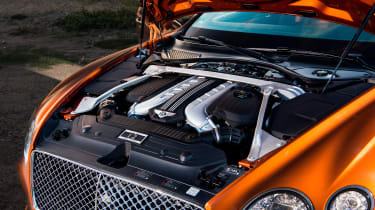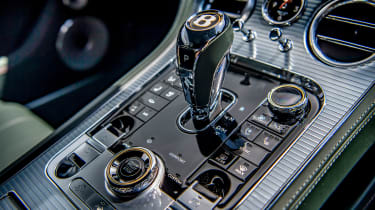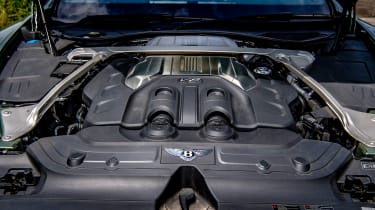Bentley Continental GT (Mk3, 2018 - 2024) – engine, gearbox and technical highlights
The Continental GT’s available with both a W12 and V8 engine, the former bespoke to Bentley
Both Continental GT coupe and Convertible models were powered by either a V8 or W12 engine. The latter is a 6-litre twin-turbo unit, which despite featuring the same capacity and a similar fundamental design as the old W12, is genuinely a brand new engine. This is also now bespoke to the Bentley brand, with Audi having dropped the W12 option for its A8, and no other make within the VW Group featuring a 12-cylinder option.
Changes inside the engine include further development of the variable valve timing system and the firing order, making the engine smoother yet more sporting in feel. The outputs are impressive. Maximum power is rated at 650bhp between 5000 and 6000rpm, while maximum torque of 664lb ft is produced on a broad plateau between 1500 and 5000rpm.
> Bentley Continental GT Speed 2024 review – driving the most powerful Bentley yet
The V8 option is more familiar, sharing the same 4-litre hot-V twin-turbo unit found in a range of Audi RS models, Porsches and the Lamborghini Urus. It does have its own bespoke mapping, but otherwise shares its critical figures with the Porsche Cayenne Turbo specifically, with 542bhp produced at 6000rpm, and a peak torque figure of 568lb ft between 2000 and 4500rpm.
Both engines are paired to an eight-speed dual-clutch transmission, feeding power to a rear-biased all-wheel-drive system. While a dual-clutch system might not sound like the most natural pairing, it’s a superb example of the type and delivers an impressive balance of smoothness and responsiveness.
More reviews
Group tests
In-depth reviews
Reviews
- Bentley Continental GT 2025 review – Crewe's DB12 rival has the Aston Martin licked
- Bentley Continental GT Speed 2025 review – driving the most powerful Bentley yet
- Bentley Continental GTC Speed 2025 review – huge power, huge weight, huge price
- Bentley Continental GT W12 (Mk1, 2003-2010): the car that saved Bentley
- Bentley Continental GT S 2023 review
- Bentley Continental GT Speed Convertible 2021 review – British grand touring on form
Rather than having to work with hand-me-down parts from the VW empire, Bentley’s engineers were involved with Porsche in the development of the Conti’s new chassis right from the word go, so they could dictate exactly what they were going to end up with.
The engine is set around 150mm further back in the chassis than before, which in itself makes a huge difference to the GT’s fundamental balance. At the front there are double wishbones, with a multi-link arrangement at the rear, but at both ends there is a three-chamber air suspension system with 48V electronically “active” anti-roll bars on both axles.
A key mechanical addition to the Speed is the use of an electronically controlled limited-slip rear differential. It might sound counterintuitive to fit an eLSD to a car with all-wheel drive, but it fundamentally changes the Speed’s behaviour at high speeds, cleaning up any sideways action and making it as comfortable with some degree of opposite lock as no car with a kerb weight of 2273kg has the right to. The GT S misses out on the rear diff, but gains the active anti-roll bars as standard. Weight for the V8 models varies depending on technical specification, but at its lightest sits at 2165kg.
The brakes are some of the biggest seen on any production road car, with 420mm cast iron ventilated discs at the front and 380mm rotors at the back, but both Speed and GT C models can be fitted with the optional ceramics which measure in at 440mm on the front axle and 410mm on the rear, making them the biggest brakes fitted to any production car. Both cast iron and carbon-ceramic brake packages use colossal 10-piston calipers on the front axle and 4-piston calipers out back.
And as before, the GT is four-wheel drive – and needs to be with that much torque available from such low revs. But the way in which the power and torque is deployed has been radically altered in the new car, and switching between the three different drive modes available is key to the distribution of energy, and to the personality of the car in general.





